Strategic Analysis of John Lewis: Business Strategy Report
VerifiedAdded on 2021/02/16
|13
|4161
|23
Report
AI Summary
This report offers a comprehensive analysis of John Lewis's business strategy. It begins with an introduction to business strategy and the chosen organization. The report delves into the macro environment using PESTEL analysis, examining political, economic, social, technological, environmental, and legal factors. The internal environment is then assessed using SWOT analysis and the VRIO model to determine the firm's capabilities. Furthermore, the competitive landscape is evaluated through Porter's Five Forces model. Finally, the report explores strategic planning using models such as the Ansoff Matrix to devise strategic plans for the growth and development of the business. The report provides a holistic view of the company's strategic position and potential growth avenues.
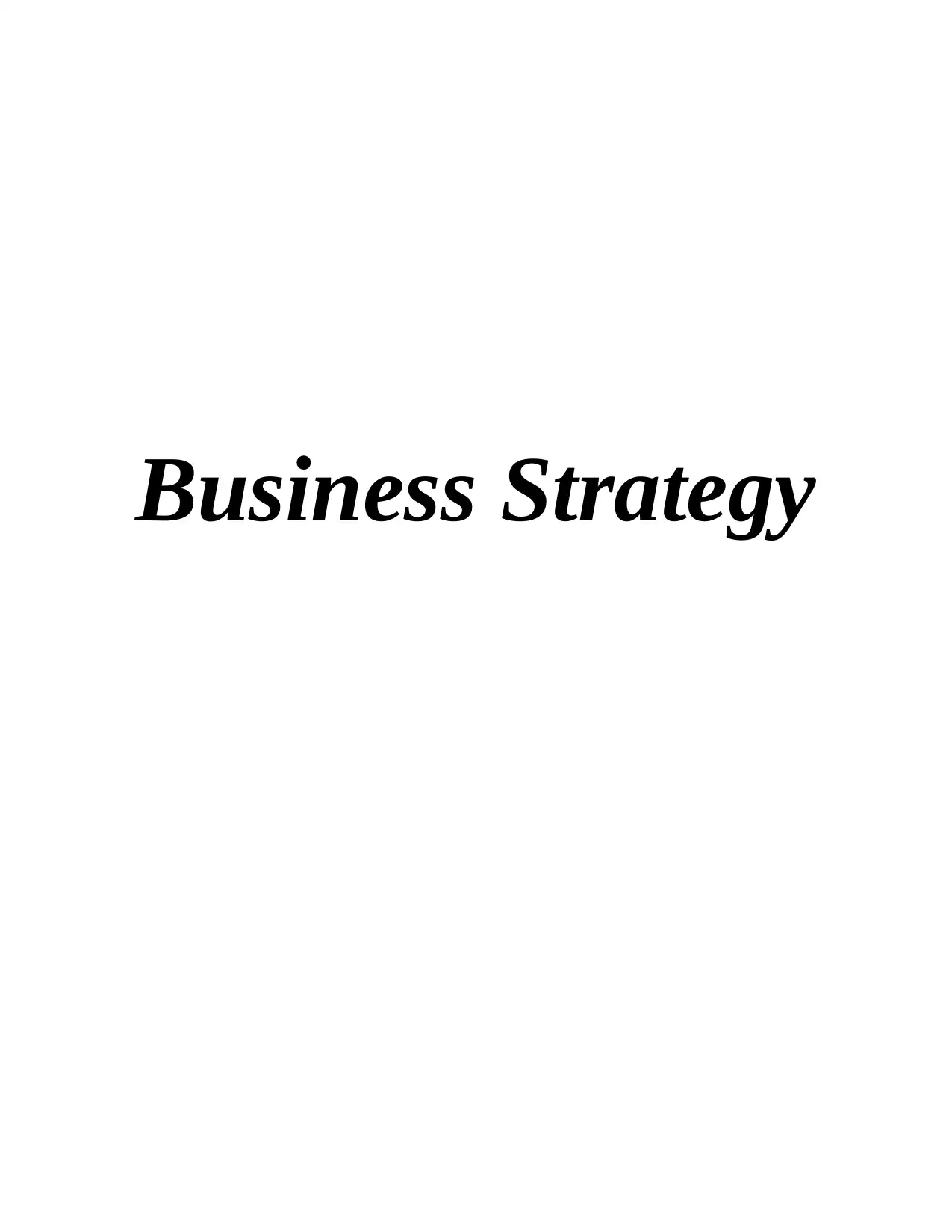
Business Strategy
Paraphrase This Document
Need a fresh take? Get an instant paraphrase of this document with our AI Paraphraser
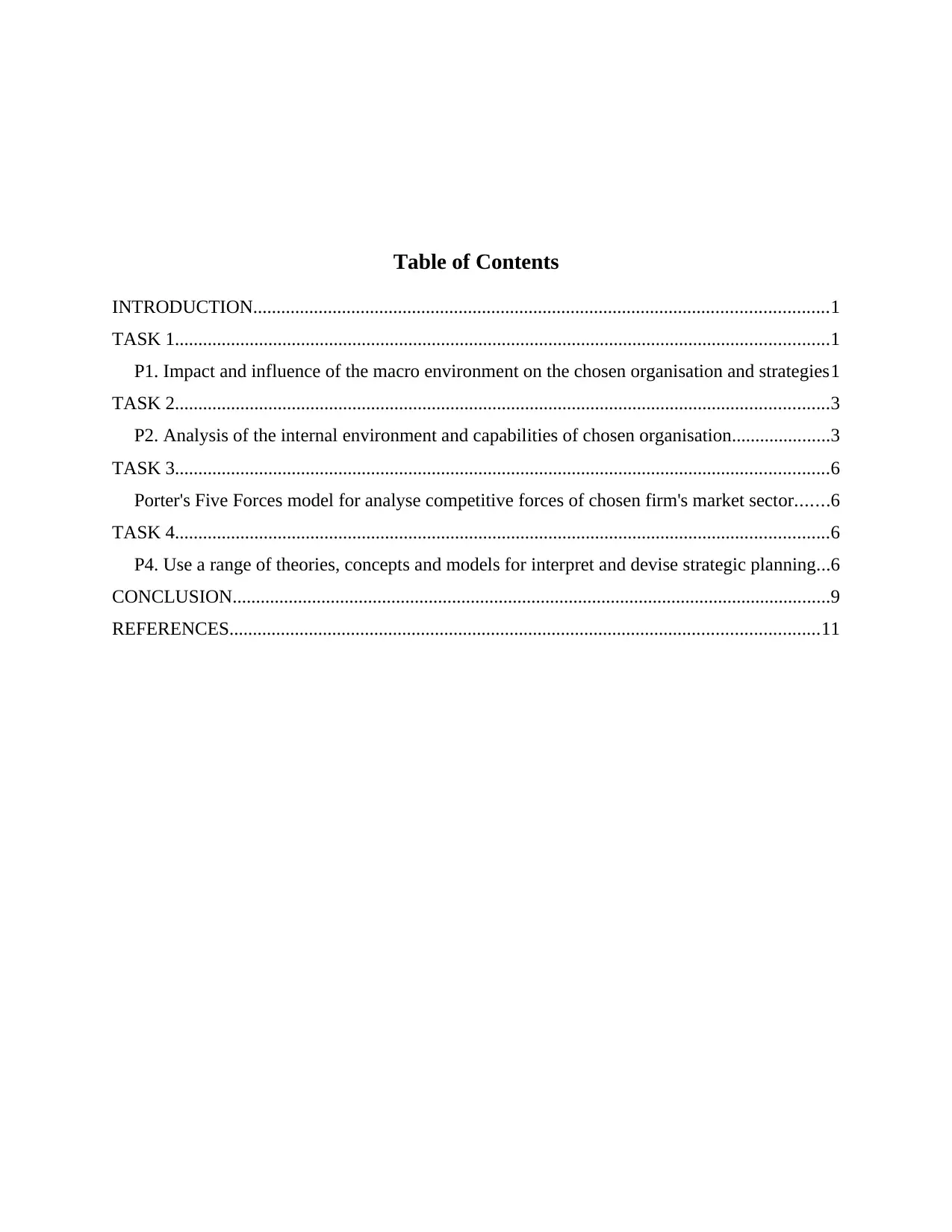
Table of Contents
INTRODUCTION...........................................................................................................................1
TASK 1............................................................................................................................................1
P1. Impact and influence of the macro environment on the chosen organisation and strategies1
TASK 2............................................................................................................................................3
P2. Analysis of the internal environment and capabilities of chosen organisation.....................3
TASK 3............................................................................................................................................6
Porter's Five Forces model for analyse competitive forces of chosen firm's market sector.......6
TASK 4............................................................................................................................................6
P4. Use a range of theories, concepts and models for interpret and devise strategic planning...6
CONCLUSION................................................................................................................................9
REFERENCES..............................................................................................................................11
INTRODUCTION...........................................................................................................................1
TASK 1............................................................................................................................................1
P1. Impact and influence of the macro environment on the chosen organisation and strategies1
TASK 2............................................................................................................................................3
P2. Analysis of the internal environment and capabilities of chosen organisation.....................3
TASK 3............................................................................................................................................6
Porter's Five Forces model for analyse competitive forces of chosen firm's market sector.......6
TASK 4............................................................................................................................................6
P4. Use a range of theories, concepts and models for interpret and devise strategic planning...6
CONCLUSION................................................................................................................................9
REFERENCES..............................................................................................................................11
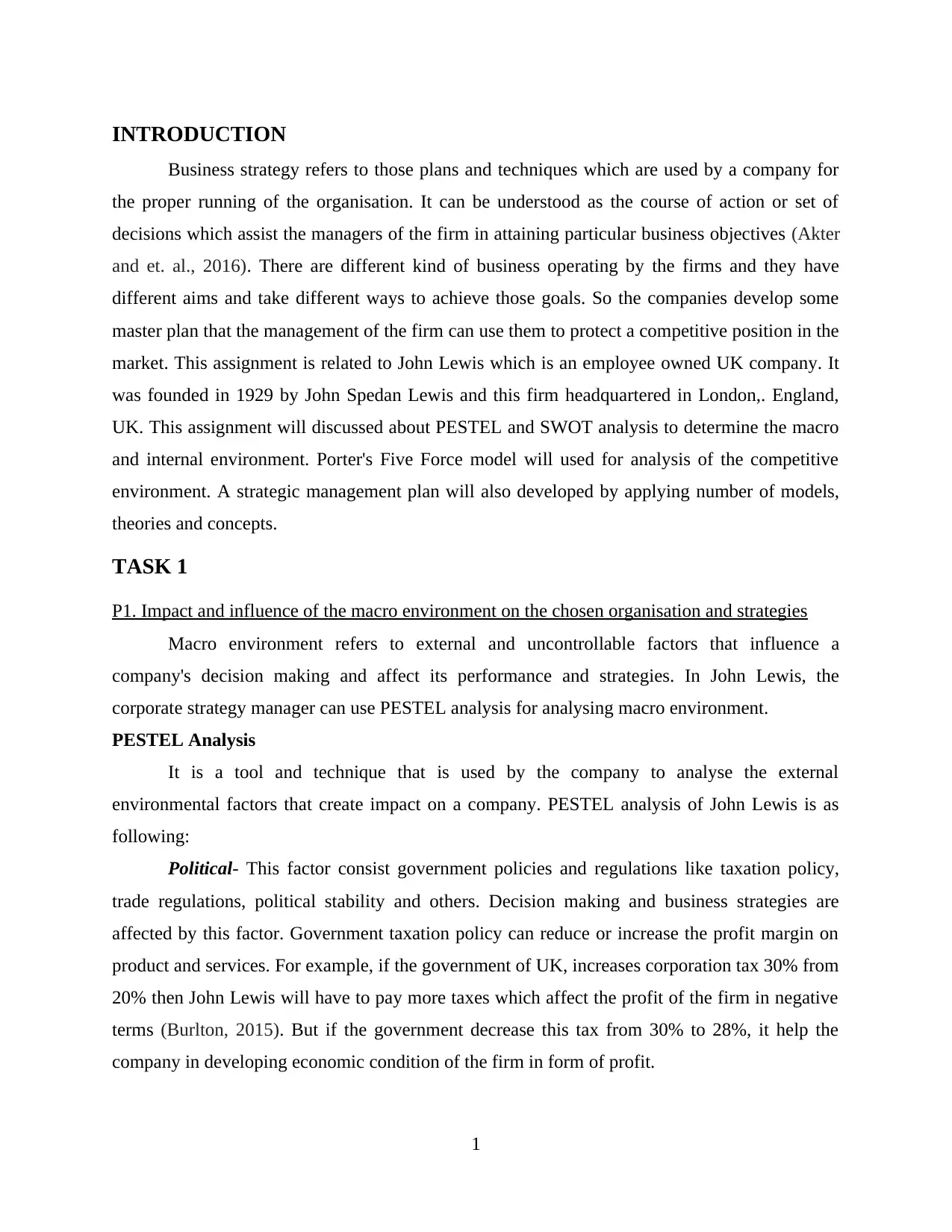
INTRODUCTION
Business strategy refers to those plans and techniques which are used by a company for
the proper running of the organisation. It can be understood as the course of action or set of
decisions which assist the managers of the firm in attaining particular business objectives (Akter
and et. al., 2016). There are different kind of business operating by the firms and they have
different aims and take different ways to achieve those goals. So the companies develop some
master plan that the management of the firm can use them to protect a competitive position in the
market. This assignment is related to John Lewis which is an employee owned UK company. It
was founded in 1929 by John Spedan Lewis and this firm headquartered in London,. England,
UK. This assignment will discussed about PESTEL and SWOT analysis to determine the macro
and internal environment. Porter's Five Force model will used for analysis of the competitive
environment. A strategic management plan will also developed by applying number of models,
theories and concepts.
TASK 1
P1. Impact and influence of the macro environment on the chosen organisation and strategies
Macro environment refers to external and uncontrollable factors that influence a
company's decision making and affect its performance and strategies. In John Lewis, the
corporate strategy manager can use PESTEL analysis for analysing macro environment.
PESTEL Analysis
It is a tool and technique that is used by the company to analyse the external
environmental factors that create impact on a company. PESTEL analysis of John Lewis is as
following:
Political- This factor consist government policies and regulations like taxation policy,
trade regulations, political stability and others. Decision making and business strategies are
affected by this factor. Government taxation policy can reduce or increase the profit margin on
product and services. For example, if the government of UK, increases corporation tax 30% from
20% then John Lewis will have to pay more taxes which affect the profit of the firm in negative
terms (Burlton, 2015). But if the government decrease this tax from 30% to 28%, it help the
company in developing economic condition of the firm in form of profit.
1
Business strategy refers to those plans and techniques which are used by a company for
the proper running of the organisation. It can be understood as the course of action or set of
decisions which assist the managers of the firm in attaining particular business objectives (Akter
and et. al., 2016). There are different kind of business operating by the firms and they have
different aims and take different ways to achieve those goals. So the companies develop some
master plan that the management of the firm can use them to protect a competitive position in the
market. This assignment is related to John Lewis which is an employee owned UK company. It
was founded in 1929 by John Spedan Lewis and this firm headquartered in London,. England,
UK. This assignment will discussed about PESTEL and SWOT analysis to determine the macro
and internal environment. Porter's Five Force model will used for analysis of the competitive
environment. A strategic management plan will also developed by applying number of models,
theories and concepts.
TASK 1
P1. Impact and influence of the macro environment on the chosen organisation and strategies
Macro environment refers to external and uncontrollable factors that influence a
company's decision making and affect its performance and strategies. In John Lewis, the
corporate strategy manager can use PESTEL analysis for analysing macro environment.
PESTEL Analysis
It is a tool and technique that is used by the company to analyse the external
environmental factors that create impact on a company. PESTEL analysis of John Lewis is as
following:
Political- This factor consist government policies and regulations like taxation policy,
trade regulations, political stability and others. Decision making and business strategies are
affected by this factor. Government taxation policy can reduce or increase the profit margin on
product and services. For example, if the government of UK, increases corporation tax 30% from
20% then John Lewis will have to pay more taxes which affect the profit of the firm in negative
terms (Burlton, 2015). But if the government decrease this tax from 30% to 28%, it help the
company in developing economic condition of the firm in form of profit.
1
⊘ This is a preview!⊘
Do you want full access?
Subscribe today to unlock all pages.

Trusted by 1+ million students worldwide
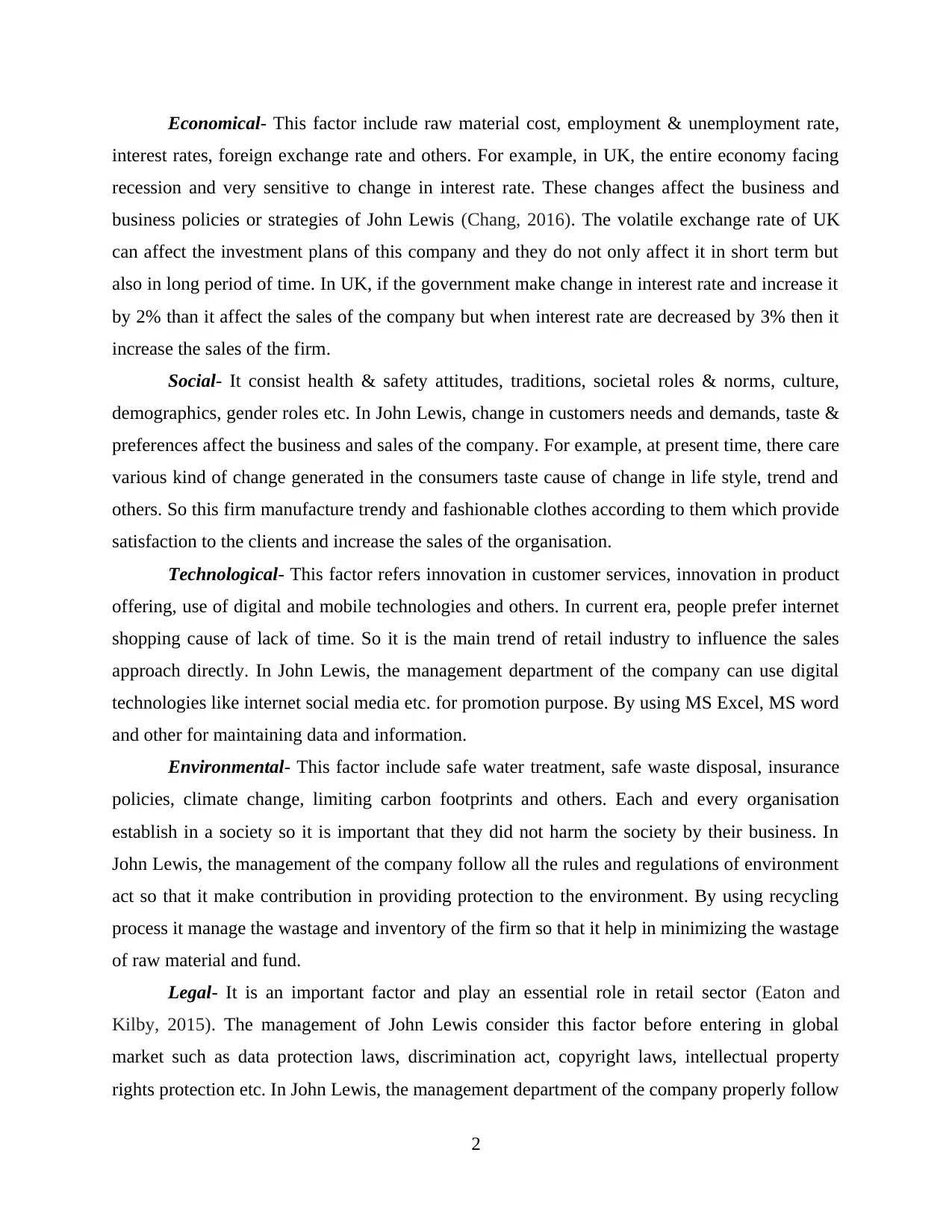
Economical- This factor include raw material cost, employment & unemployment rate,
interest rates, foreign exchange rate and others. For example, in UK, the entire economy facing
recession and very sensitive to change in interest rate. These changes affect the business and
business policies or strategies of John Lewis (Chang, 2016). The volatile exchange rate of UK
can affect the investment plans of this company and they do not only affect it in short term but
also in long period of time. In UK, if the government make change in interest rate and increase it
by 2% than it affect the sales of the company but when interest rate are decreased by 3% then it
increase the sales of the firm.
Social- It consist health & safety attitudes, traditions, societal roles & norms, culture,
demographics, gender roles etc. In John Lewis, change in customers needs and demands, taste &
preferences affect the business and sales of the company. For example, at present time, there care
various kind of change generated in the consumers taste cause of change in life style, trend and
others. So this firm manufacture trendy and fashionable clothes according to them which provide
satisfaction to the clients and increase the sales of the organisation.
Technological- This factor refers innovation in customer services, innovation in product
offering, use of digital and mobile technologies and others. In current era, people prefer internet
shopping cause of lack of time. So it is the main trend of retail industry to influence the sales
approach directly. In John Lewis, the management department of the company can use digital
technologies like internet social media etc. for promotion purpose. By using MS Excel, MS word
and other for maintaining data and information.
Environmental- This factor include safe water treatment, safe waste disposal, insurance
policies, climate change, limiting carbon footprints and others. Each and every organisation
establish in a society so it is important that they did not harm the society by their business. In
John Lewis, the management of the company follow all the rules and regulations of environment
act so that it make contribution in providing protection to the environment. By using recycling
process it manage the wastage and inventory of the firm so that it help in minimizing the wastage
of raw material and fund.
Legal- It is an important factor and play an essential role in retail sector (Eaton and
Kilby, 2015). The management of John Lewis consider this factor before entering in global
market such as data protection laws, discrimination act, copyright laws, intellectual property
rights protection etc. In John Lewis, the management department of the company properly follow
2
interest rates, foreign exchange rate and others. For example, in UK, the entire economy facing
recession and very sensitive to change in interest rate. These changes affect the business and
business policies or strategies of John Lewis (Chang, 2016). The volatile exchange rate of UK
can affect the investment plans of this company and they do not only affect it in short term but
also in long period of time. In UK, if the government make change in interest rate and increase it
by 2% than it affect the sales of the company but when interest rate are decreased by 3% then it
increase the sales of the firm.
Social- It consist health & safety attitudes, traditions, societal roles & norms, culture,
demographics, gender roles etc. In John Lewis, change in customers needs and demands, taste &
preferences affect the business and sales of the company. For example, at present time, there care
various kind of change generated in the consumers taste cause of change in life style, trend and
others. So this firm manufacture trendy and fashionable clothes according to them which provide
satisfaction to the clients and increase the sales of the organisation.
Technological- This factor refers innovation in customer services, innovation in product
offering, use of digital and mobile technologies and others. In current era, people prefer internet
shopping cause of lack of time. So it is the main trend of retail industry to influence the sales
approach directly. In John Lewis, the management department of the company can use digital
technologies like internet social media etc. for promotion purpose. By using MS Excel, MS word
and other for maintaining data and information.
Environmental- This factor include safe water treatment, safe waste disposal, insurance
policies, climate change, limiting carbon footprints and others. Each and every organisation
establish in a society so it is important that they did not harm the society by their business. In
John Lewis, the management of the company follow all the rules and regulations of environment
act so that it make contribution in providing protection to the environment. By using recycling
process it manage the wastage and inventory of the firm so that it help in minimizing the wastage
of raw material and fund.
Legal- It is an important factor and play an essential role in retail sector (Eaton and
Kilby, 2015). The management of John Lewis consider this factor before entering in global
market such as data protection laws, discrimination act, copyright laws, intellectual property
rights protection etc. In John Lewis, the management department of the company properly follow
2
Paraphrase This Document
Need a fresh take? Get an instant paraphrase of this document with our AI Paraphraser
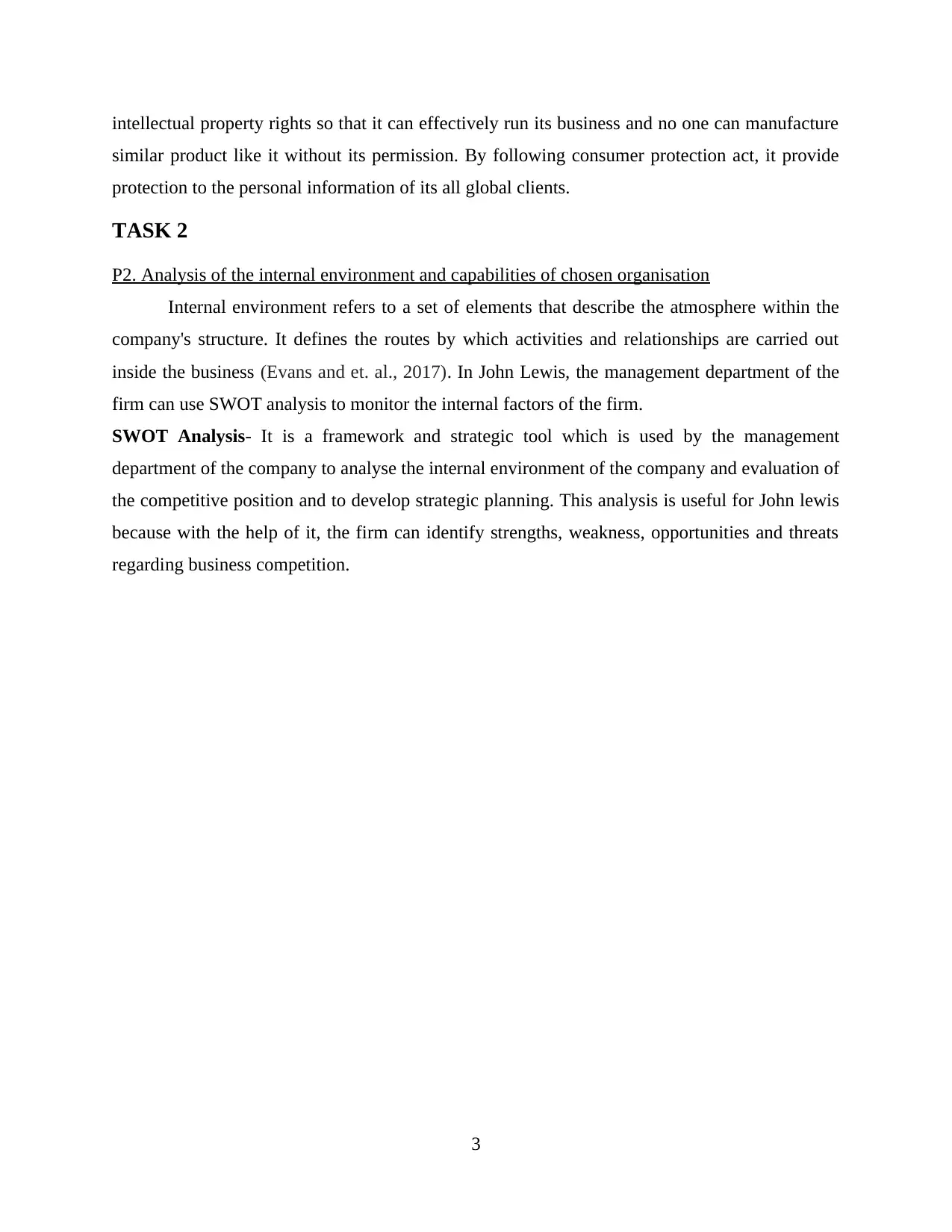
intellectual property rights so that it can effectively run its business and no one can manufacture
similar product like it without its permission. By following consumer protection act, it provide
protection to the personal information of its all global clients.
TASK 2
P2. Analysis of the internal environment and capabilities of chosen organisation
Internal environment refers to a set of elements that describe the atmosphere within the
company's structure. It defines the routes by which activities and relationships are carried out
inside the business (Evans and et. al., 2017). In John Lewis, the management department of the
firm can use SWOT analysis to monitor the internal factors of the firm.
SWOT Analysis- It is a framework and strategic tool which is used by the management
department of the company to analyse the internal environment of the company and evaluation of
the competitive position and to develop strategic planning. This analysis is useful for John lewis
because with the help of it, the firm can identify strengths, weakness, opportunities and threats
regarding business competition.
3
similar product like it without its permission. By following consumer protection act, it provide
protection to the personal information of its all global clients.
TASK 2
P2. Analysis of the internal environment and capabilities of chosen organisation
Internal environment refers to a set of elements that describe the atmosphere within the
company's structure. It defines the routes by which activities and relationships are carried out
inside the business (Evans and et. al., 2017). In John Lewis, the management department of the
firm can use SWOT analysis to monitor the internal factors of the firm.
SWOT Analysis- It is a framework and strategic tool which is used by the management
department of the company to analyse the internal environment of the company and evaluation of
the competitive position and to develop strategic planning. This analysis is useful for John lewis
because with the help of it, the firm can identify strengths, weakness, opportunities and threats
regarding business competition.
3
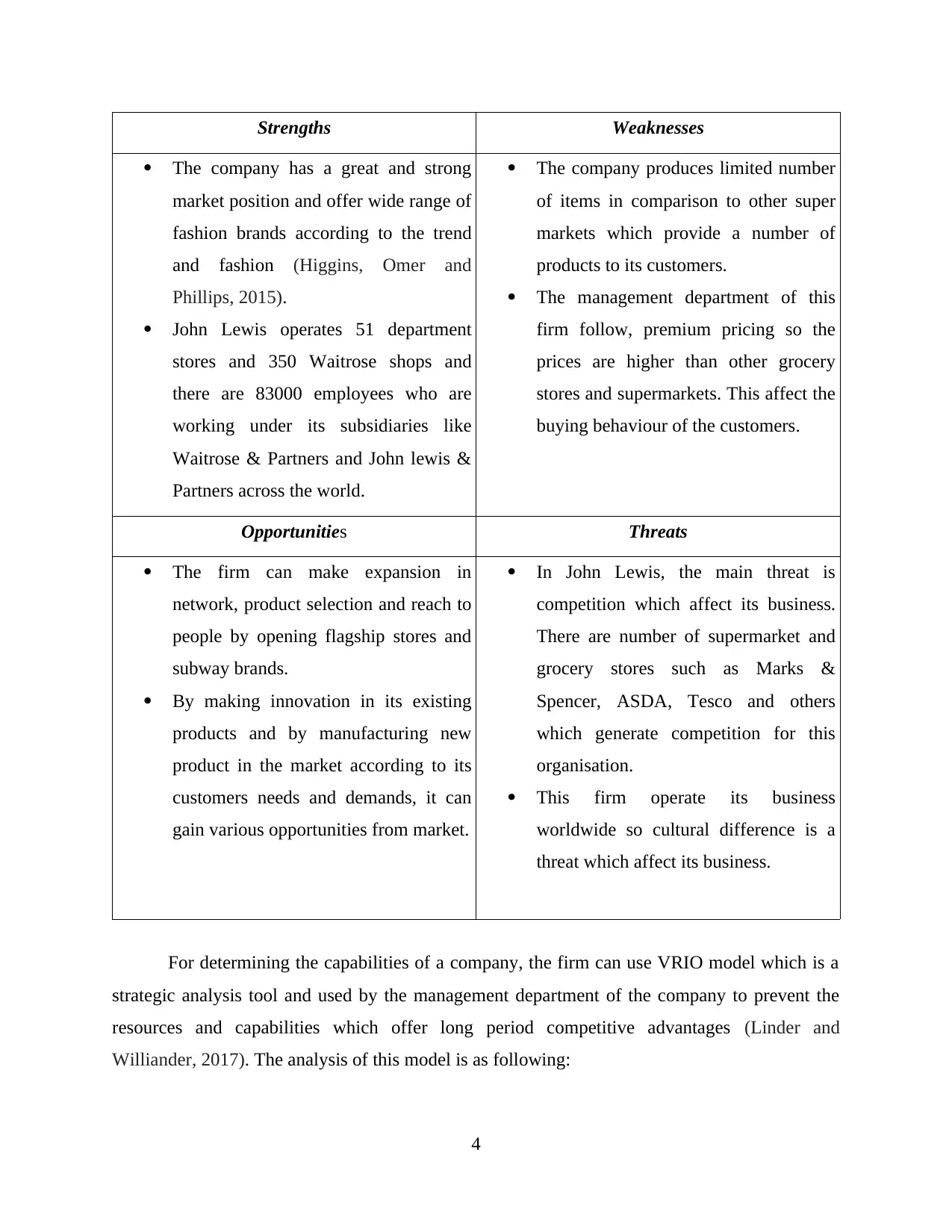
Strengths Weaknesses
The company has a great and strong
market position and offer wide range of
fashion brands according to the trend
and fashion (Higgins, Omer and
Phillips, 2015).
John Lewis operates 51 department
stores and 350 Waitrose shops and
there are 83000 employees who are
working under its subsidiaries like
Waitrose & Partners and John lewis &
Partners across the world.
The company produces limited number
of items in comparison to other super
markets which provide a number of
products to its customers.
The management department of this
firm follow, premium pricing so the
prices are higher than other grocery
stores and supermarkets. This affect the
buying behaviour of the customers.
Opportunities Threats
The firm can make expansion in
network, product selection and reach to
people by opening flagship stores and
subway brands.
By making innovation in its existing
products and by manufacturing new
product in the market according to its
customers needs and demands, it can
gain various opportunities from market.
In John Lewis, the main threat is
competition which affect its business.
There are number of supermarket and
grocery stores such as Marks &
Spencer, ASDA, Tesco and others
which generate competition for this
organisation.
This firm operate its business
worldwide so cultural difference is a
threat which affect its business.
For determining the capabilities of a company, the firm can use VRIO model which is a
strategic analysis tool and used by the management department of the company to prevent the
resources and capabilities which offer long period competitive advantages (Linder and
Williander, 2017). The analysis of this model is as following:
4
The company has a great and strong
market position and offer wide range of
fashion brands according to the trend
and fashion (Higgins, Omer and
Phillips, 2015).
John Lewis operates 51 department
stores and 350 Waitrose shops and
there are 83000 employees who are
working under its subsidiaries like
Waitrose & Partners and John lewis &
Partners across the world.
The company produces limited number
of items in comparison to other super
markets which provide a number of
products to its customers.
The management department of this
firm follow, premium pricing so the
prices are higher than other grocery
stores and supermarkets. This affect the
buying behaviour of the customers.
Opportunities Threats
The firm can make expansion in
network, product selection and reach to
people by opening flagship stores and
subway brands.
By making innovation in its existing
products and by manufacturing new
product in the market according to its
customers needs and demands, it can
gain various opportunities from market.
In John Lewis, the main threat is
competition which affect its business.
There are number of supermarket and
grocery stores such as Marks &
Spencer, ASDA, Tesco and others
which generate competition for this
organisation.
This firm operate its business
worldwide so cultural difference is a
threat which affect its business.
For determining the capabilities of a company, the firm can use VRIO model which is a
strategic analysis tool and used by the management department of the company to prevent the
resources and capabilities which offer long period competitive advantages (Linder and
Williander, 2017). The analysis of this model is as following:
4
⊘ This is a preview!⊘
Do you want full access?
Subscribe today to unlock all pages.

Trusted by 1+ million students worldwide
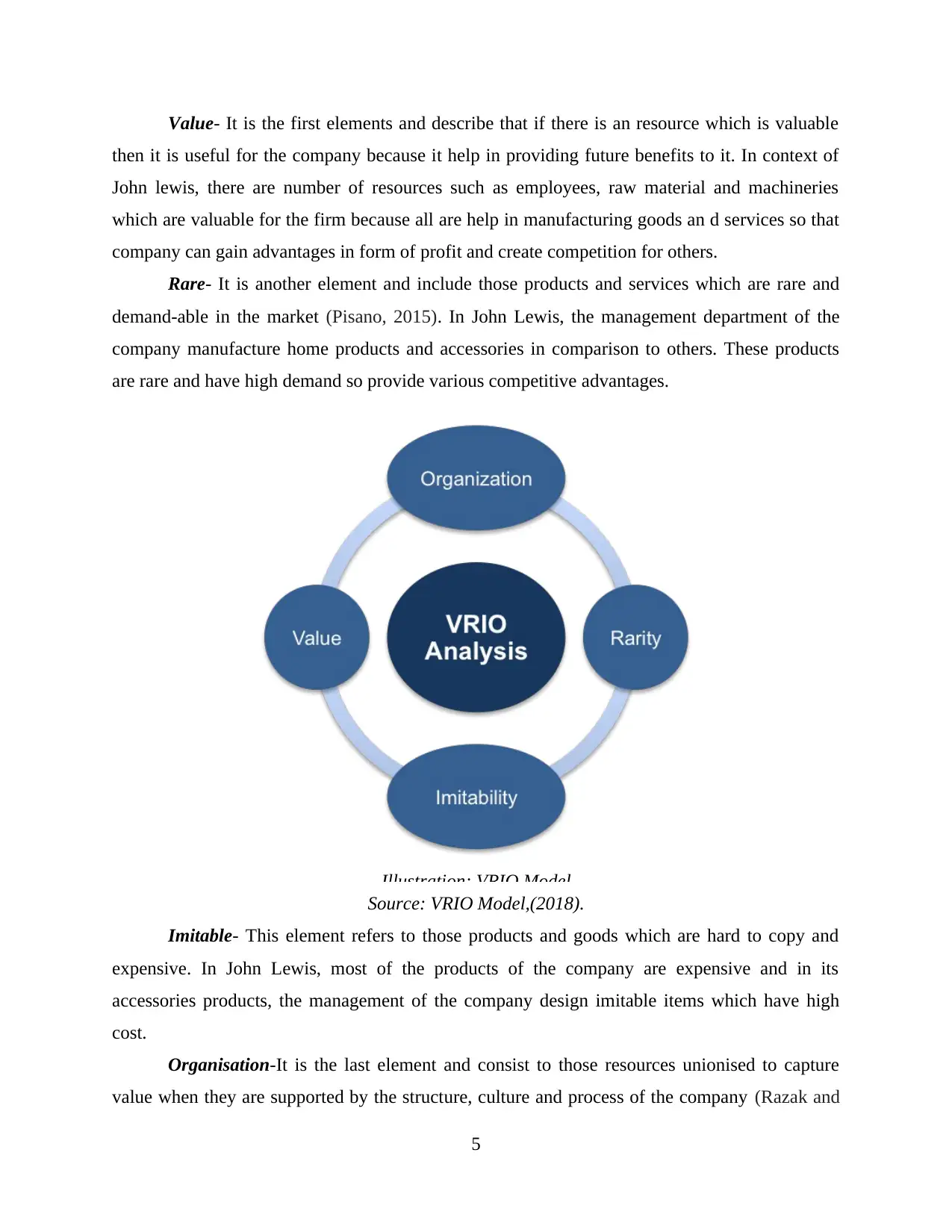
Value- It is the first elements and describe that if there is an resource which is valuable
then it is useful for the company because it help in providing future benefits to it. In context of
John lewis, there are number of resources such as employees, raw material and machineries
which are valuable for the firm because all are help in manufacturing goods an d services so that
company can gain advantages in form of profit and create competition for others.
Rare- It is another element and include those products and services which are rare and
demand-able in the market (Pisano, 2015). In John Lewis, the management department of the
company manufacture home products and accessories in comparison to others. These products
are rare and have high demand so provide various competitive advantages.
Source: VRIO Model,(2018).
Imitable- This element refers to those products and goods which are hard to copy and
expensive. In John Lewis, most of the products of the company are expensive and in its
accessories products, the management of the company design imitable items which have high
cost.
Organisation-It is the last element and consist to those resources unionised to capture
value when they are supported by the structure, culture and process of the company (Razak and
5
Illustration: VRIO Model
then it is useful for the company because it help in providing future benefits to it. In context of
John lewis, there are number of resources such as employees, raw material and machineries
which are valuable for the firm because all are help in manufacturing goods an d services so that
company can gain advantages in form of profit and create competition for others.
Rare- It is another element and include those products and services which are rare and
demand-able in the market (Pisano, 2015). In John Lewis, the management department of the
company manufacture home products and accessories in comparison to others. These products
are rare and have high demand so provide various competitive advantages.
Source: VRIO Model,(2018).
Imitable- This element refers to those products and goods which are hard to copy and
expensive. In John Lewis, most of the products of the company are expensive and in its
accessories products, the management of the company design imitable items which have high
cost.
Organisation-It is the last element and consist to those resources unionised to capture
value when they are supported by the structure, culture and process of the company (Razak and
5
Illustration: VRIO Model
Paraphrase This Document
Need a fresh take? Get an instant paraphrase of this document with our AI Paraphraser
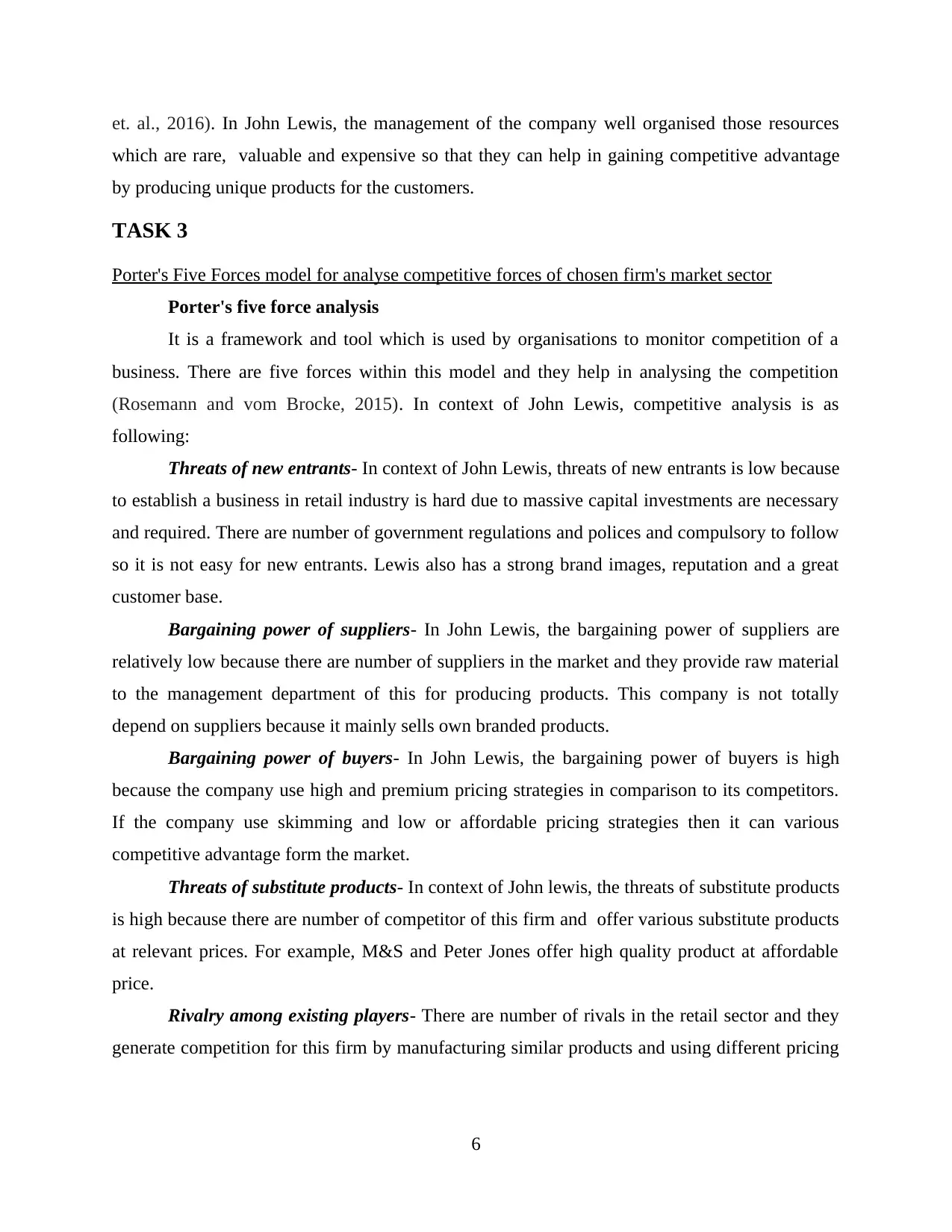
et. al., 2016). In John Lewis, the management of the company well organised those resources
which are rare, valuable and expensive so that they can help in gaining competitive advantage
by producing unique products for the customers.
TASK 3
Porter's Five Forces model for analyse competitive forces of chosen firm's market sector
Porter's five force analysis
It is a framework and tool which is used by organisations to monitor competition of a
business. There are five forces within this model and they help in analysing the competition
(Rosemann and vom Brocke, 2015). In context of John Lewis, competitive analysis is as
following:
Threats of new entrants- In context of John Lewis, threats of new entrants is low because
to establish a business in retail industry is hard due to massive capital investments are necessary
and required. There are number of government regulations and polices and compulsory to follow
so it is not easy for new entrants. Lewis also has a strong brand images, reputation and a great
customer base.
Bargaining power of suppliers- In John Lewis, the bargaining power of suppliers are
relatively low because there are number of suppliers in the market and they provide raw material
to the management department of this for producing products. This company is not totally
depend on suppliers because it mainly sells own branded products.
Bargaining power of buyers- In John Lewis, the bargaining power of buyers is high
because the company use high and premium pricing strategies in comparison to its competitors.
If the company use skimming and low or affordable pricing strategies then it can various
competitive advantage form the market.
Threats of substitute products- In context of John lewis, the threats of substitute products
is high because there are number of competitor of this firm and offer various substitute products
at relevant prices. For example, M&S and Peter Jones offer high quality product at affordable
price.
Rivalry among existing players- There are number of rivals in the retail sector and they
generate competition for this firm by manufacturing similar products and using different pricing
6
which are rare, valuable and expensive so that they can help in gaining competitive advantage
by producing unique products for the customers.
TASK 3
Porter's Five Forces model for analyse competitive forces of chosen firm's market sector
Porter's five force analysis
It is a framework and tool which is used by organisations to monitor competition of a
business. There are five forces within this model and they help in analysing the competition
(Rosemann and vom Brocke, 2015). In context of John Lewis, competitive analysis is as
following:
Threats of new entrants- In context of John Lewis, threats of new entrants is low because
to establish a business in retail industry is hard due to massive capital investments are necessary
and required. There are number of government regulations and polices and compulsory to follow
so it is not easy for new entrants. Lewis also has a strong brand images, reputation and a great
customer base.
Bargaining power of suppliers- In John Lewis, the bargaining power of suppliers are
relatively low because there are number of suppliers in the market and they provide raw material
to the management department of this for producing products. This company is not totally
depend on suppliers because it mainly sells own branded products.
Bargaining power of buyers- In John Lewis, the bargaining power of buyers is high
because the company use high and premium pricing strategies in comparison to its competitors.
If the company use skimming and low or affordable pricing strategies then it can various
competitive advantage form the market.
Threats of substitute products- In context of John lewis, the threats of substitute products
is high because there are number of competitor of this firm and offer various substitute products
at relevant prices. For example, M&S and Peter Jones offer high quality product at affordable
price.
Rivalry among existing players- There are number of rivals in the retail sector and they
generate competition for this firm by manufacturing similar products and using different pricing
6
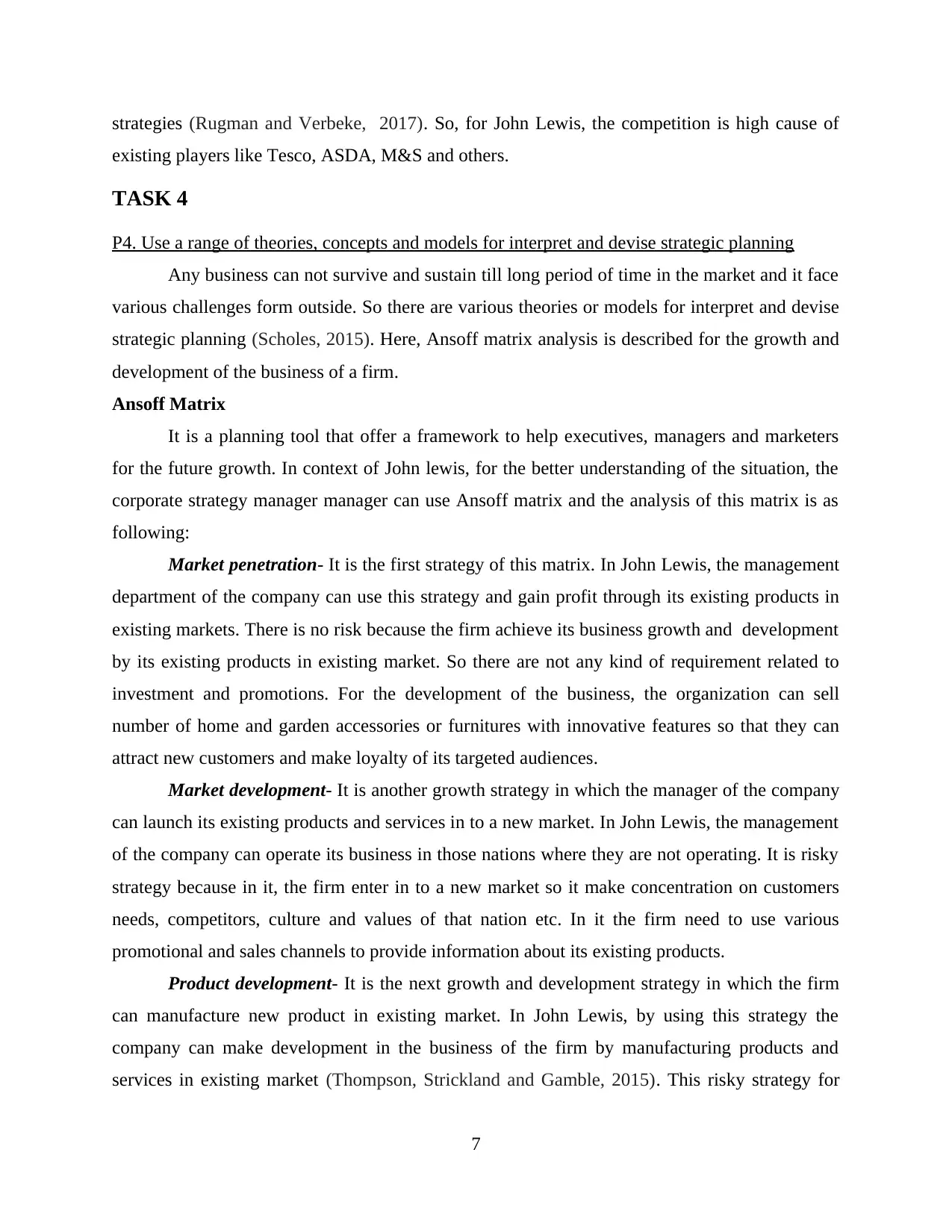
strategies (Rugman and Verbeke, 2017). So, for John Lewis, the competition is high cause of
existing players like Tesco, ASDA, M&S and others.
TASK 4
P4. Use a range of theories, concepts and models for interpret and devise strategic planning
Any business can not survive and sustain till long period of time in the market and it face
various challenges form outside. So there are various theories or models for interpret and devise
strategic planning (Scholes, 2015). Here, Ansoff matrix analysis is described for the growth and
development of the business of a firm.
Ansoff Matrix
It is a planning tool that offer a framework to help executives, managers and marketers
for the future growth. In context of John lewis, for the better understanding of the situation, the
corporate strategy manager manager can use Ansoff matrix and the analysis of this matrix is as
following:
Market penetration- It is the first strategy of this matrix. In John Lewis, the management
department of the company can use this strategy and gain profit through its existing products in
existing markets. There is no risk because the firm achieve its business growth and development
by its existing products in existing market. So there are not any kind of requirement related to
investment and promotions. For the development of the business, the organization can sell
number of home and garden accessories or furnitures with innovative features so that they can
attract new customers and make loyalty of its targeted audiences.
Market development- It is another growth strategy in which the manager of the company
can launch its existing products and services in to a new market. In John Lewis, the management
of the company can operate its business in those nations where they are not operating. It is risky
strategy because in it, the firm enter in to a new market so it make concentration on customers
needs, competitors, culture and values of that nation etc. In it the firm need to use various
promotional and sales channels to provide information about its existing products.
Product development- It is the next growth and development strategy in which the firm
can manufacture new product in existing market. In John Lewis, by using this strategy the
company can make development in the business of the firm by manufacturing products and
services in existing market (Thompson, Strickland and Gamble, 2015). This risky strategy for
7
existing players like Tesco, ASDA, M&S and others.
TASK 4
P4. Use a range of theories, concepts and models for interpret and devise strategic planning
Any business can not survive and sustain till long period of time in the market and it face
various challenges form outside. So there are various theories or models for interpret and devise
strategic planning (Scholes, 2015). Here, Ansoff matrix analysis is described for the growth and
development of the business of a firm.
Ansoff Matrix
It is a planning tool that offer a framework to help executives, managers and marketers
for the future growth. In context of John lewis, for the better understanding of the situation, the
corporate strategy manager manager can use Ansoff matrix and the analysis of this matrix is as
following:
Market penetration- It is the first strategy of this matrix. In John Lewis, the management
department of the company can use this strategy and gain profit through its existing products in
existing markets. There is no risk because the firm achieve its business growth and development
by its existing products in existing market. So there are not any kind of requirement related to
investment and promotions. For the development of the business, the organization can sell
number of home and garden accessories or furnitures with innovative features so that they can
attract new customers and make loyalty of its targeted audiences.
Market development- It is another growth strategy in which the manager of the company
can launch its existing products and services in to a new market. In John Lewis, the management
of the company can operate its business in those nations where they are not operating. It is risky
strategy because in it, the firm enter in to a new market so it make concentration on customers
needs, competitors, culture and values of that nation etc. In it the firm need to use various
promotional and sales channels to provide information about its existing products.
Product development- It is the next growth and development strategy in which the firm
can manufacture new product in existing market. In John Lewis, by using this strategy the
company can make development in the business of the firm by manufacturing products and
services in existing market (Thompson, Strickland and Gamble, 2015). This risky strategy for
7
⊘ This is a preview!⊘
Do you want full access?
Subscribe today to unlock all pages.

Trusted by 1+ million students worldwide
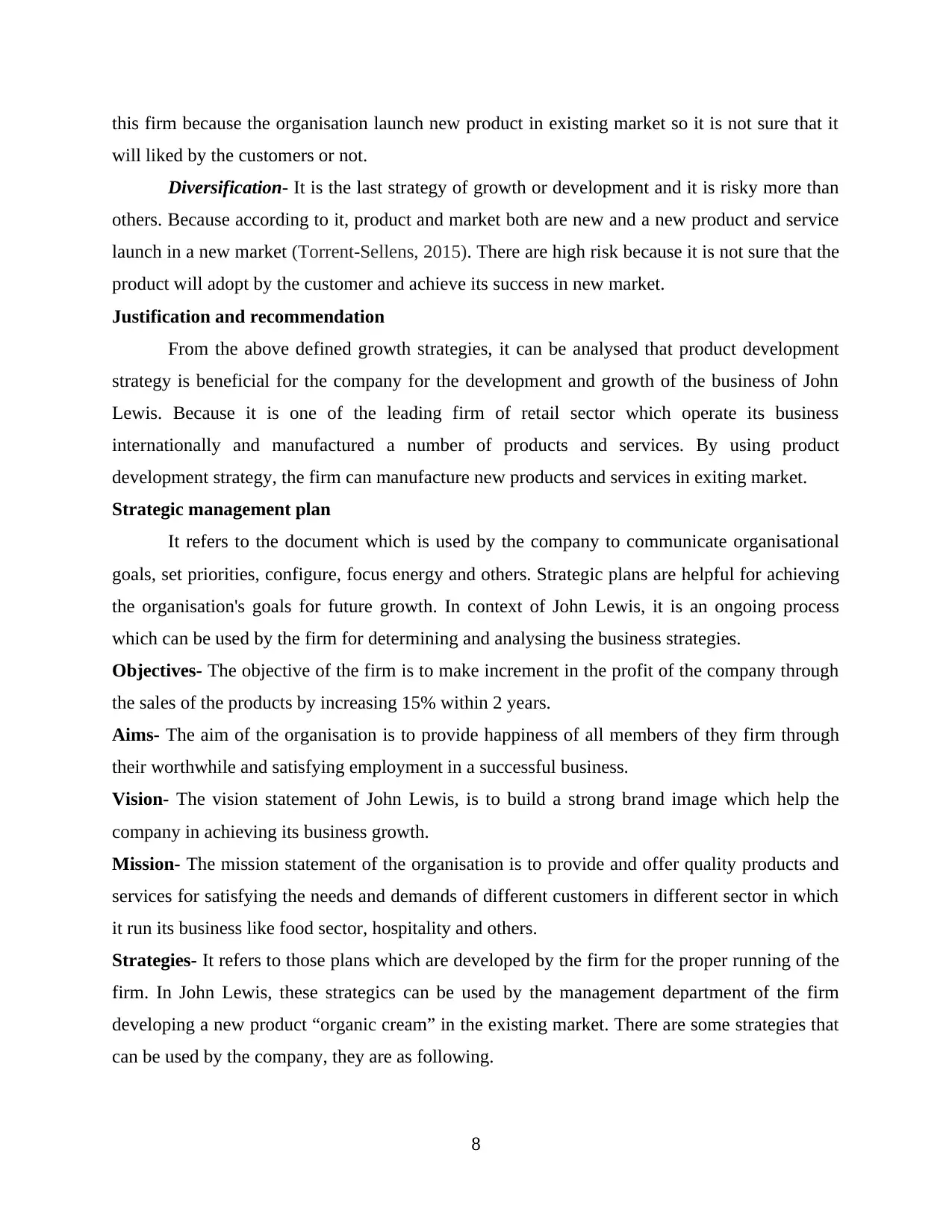
this firm because the organisation launch new product in existing market so it is not sure that it
will liked by the customers or not.
Diversification- It is the last strategy of growth or development and it is risky more than
others. Because according to it, product and market both are new and a new product and service
launch in a new market (Torrent-Sellens, 2015). There are high risk because it is not sure that the
product will adopt by the customer and achieve its success in new market.
Justification and recommendation
From the above defined growth strategies, it can be analysed that product development
strategy is beneficial for the company for the development and growth of the business of John
Lewis. Because it is one of the leading firm of retail sector which operate its business
internationally and manufactured a number of products and services. By using product
development strategy, the firm can manufacture new products and services in exiting market.
Strategic management plan
It refers to the document which is used by the company to communicate organisational
goals, set priorities, configure, focus energy and others. Strategic plans are helpful for achieving
the organisation's goals for future growth. In context of John Lewis, it is an ongoing process
which can be used by the firm for determining and analysing the business strategies.
Objectives- The objective of the firm is to make increment in the profit of the company through
the sales of the products by increasing 15% within 2 years.
Aims- The aim of the organisation is to provide happiness of all members of they firm through
their worthwhile and satisfying employment in a successful business.
Vision- The vision statement of John Lewis, is to build a strong brand image which help the
company in achieving its business growth.
Mission- The mission statement of the organisation is to provide and offer quality products and
services for satisfying the needs and demands of different customers in different sector in which
it run its business like food sector, hospitality and others.
Strategies- It refers to those plans which are developed by the firm for the proper running of the
firm. In John Lewis, these strategics can be used by the management department of the firm
developing a new product “organic cream” in the existing market. There are some strategies that
can be used by the company, they are as following.
8
will liked by the customers or not.
Diversification- It is the last strategy of growth or development and it is risky more than
others. Because according to it, product and market both are new and a new product and service
launch in a new market (Torrent-Sellens, 2015). There are high risk because it is not sure that the
product will adopt by the customer and achieve its success in new market.
Justification and recommendation
From the above defined growth strategies, it can be analysed that product development
strategy is beneficial for the company for the development and growth of the business of John
Lewis. Because it is one of the leading firm of retail sector which operate its business
internationally and manufactured a number of products and services. By using product
development strategy, the firm can manufacture new products and services in exiting market.
Strategic management plan
It refers to the document which is used by the company to communicate organisational
goals, set priorities, configure, focus energy and others. Strategic plans are helpful for achieving
the organisation's goals for future growth. In context of John Lewis, it is an ongoing process
which can be used by the firm for determining and analysing the business strategies.
Objectives- The objective of the firm is to make increment in the profit of the company through
the sales of the products by increasing 15% within 2 years.
Aims- The aim of the organisation is to provide happiness of all members of they firm through
their worthwhile and satisfying employment in a successful business.
Vision- The vision statement of John Lewis, is to build a strong brand image which help the
company in achieving its business growth.
Mission- The mission statement of the organisation is to provide and offer quality products and
services for satisfying the needs and demands of different customers in different sector in which
it run its business like food sector, hospitality and others.
Strategies- It refers to those plans which are developed by the firm for the proper running of the
firm. In John Lewis, these strategics can be used by the management department of the firm
developing a new product “organic cream” in the existing market. There are some strategies that
can be used by the company, they are as following.
8
Paraphrase This Document
Need a fresh take? Get an instant paraphrase of this document with our AI Paraphraser
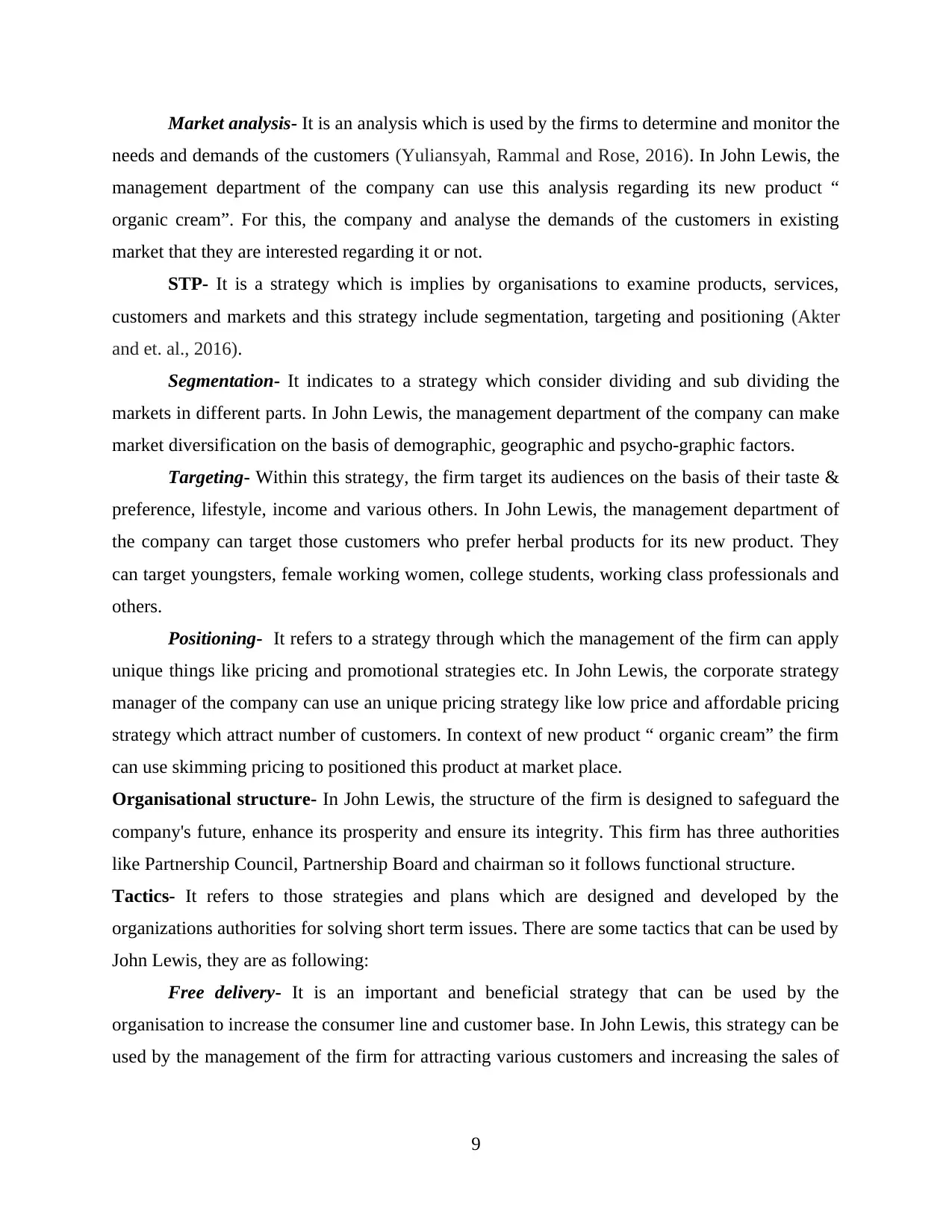
Market analysis- It is an analysis which is used by the firms to determine and monitor the
needs and demands of the customers (Yuliansyah, Rammal and Rose, 2016). In John Lewis, the
management department of the company can use this analysis regarding its new product “
organic cream”. For this, the company and analyse the demands of the customers in existing
market that they are interested regarding it or not.
STP- It is a strategy which is implies by organisations to examine products, services,
customers and markets and this strategy include segmentation, targeting and positioning (Akter
and et. al., 2016).
Segmentation- It indicates to a strategy which consider dividing and sub dividing the
markets in different parts. In John Lewis, the management department of the company can make
market diversification on the basis of demographic, geographic and psycho-graphic factors.
Targeting- Within this strategy, the firm target its audiences on the basis of their taste &
preference, lifestyle, income and various others. In John Lewis, the management department of
the company can target those customers who prefer herbal products for its new product. They
can target youngsters, female working women, college students, working class professionals and
others.
Positioning- It refers to a strategy through which the management of the firm can apply
unique things like pricing and promotional strategies etc. In John Lewis, the corporate strategy
manager of the company can use an unique pricing strategy like low price and affordable pricing
strategy which attract number of customers. In context of new product “ organic cream” the firm
can use skimming pricing to positioned this product at market place.
Organisational structure- In John Lewis, the structure of the firm is designed to safeguard the
company's future, enhance its prosperity and ensure its integrity. This firm has three authorities
like Partnership Council, Partnership Board and chairman so it follows functional structure.
Tactics- It refers to those strategies and plans which are designed and developed by the
organizations authorities for solving short term issues. There are some tactics that can be used by
John Lewis, they are as following:
Free delivery- It is an important and beneficial strategy that can be used by the
organisation to increase the consumer line and customer base. In John Lewis, this strategy can be
used by the management of the firm for attracting various customers and increasing the sales of
9
needs and demands of the customers (Yuliansyah, Rammal and Rose, 2016). In John Lewis, the
management department of the company can use this analysis regarding its new product “
organic cream”. For this, the company and analyse the demands of the customers in existing
market that they are interested regarding it or not.
STP- It is a strategy which is implies by organisations to examine products, services,
customers and markets and this strategy include segmentation, targeting and positioning (Akter
and et. al., 2016).
Segmentation- It indicates to a strategy which consider dividing and sub dividing the
markets in different parts. In John Lewis, the management department of the company can make
market diversification on the basis of demographic, geographic and psycho-graphic factors.
Targeting- Within this strategy, the firm target its audiences on the basis of their taste &
preference, lifestyle, income and various others. In John Lewis, the management department of
the company can target those customers who prefer herbal products for its new product. They
can target youngsters, female working women, college students, working class professionals and
others.
Positioning- It refers to a strategy through which the management of the firm can apply
unique things like pricing and promotional strategies etc. In John Lewis, the corporate strategy
manager of the company can use an unique pricing strategy like low price and affordable pricing
strategy which attract number of customers. In context of new product “ organic cream” the firm
can use skimming pricing to positioned this product at market place.
Organisational structure- In John Lewis, the structure of the firm is designed to safeguard the
company's future, enhance its prosperity and ensure its integrity. This firm has three authorities
like Partnership Council, Partnership Board and chairman so it follows functional structure.
Tactics- It refers to those strategies and plans which are designed and developed by the
organizations authorities for solving short term issues. There are some tactics that can be used by
John Lewis, they are as following:
Free delivery- It is an important and beneficial strategy that can be used by the
organisation to increase the consumer line and customer base. In John Lewis, this strategy can be
used by the management of the firm for attracting various customers and increasing the sales of
9
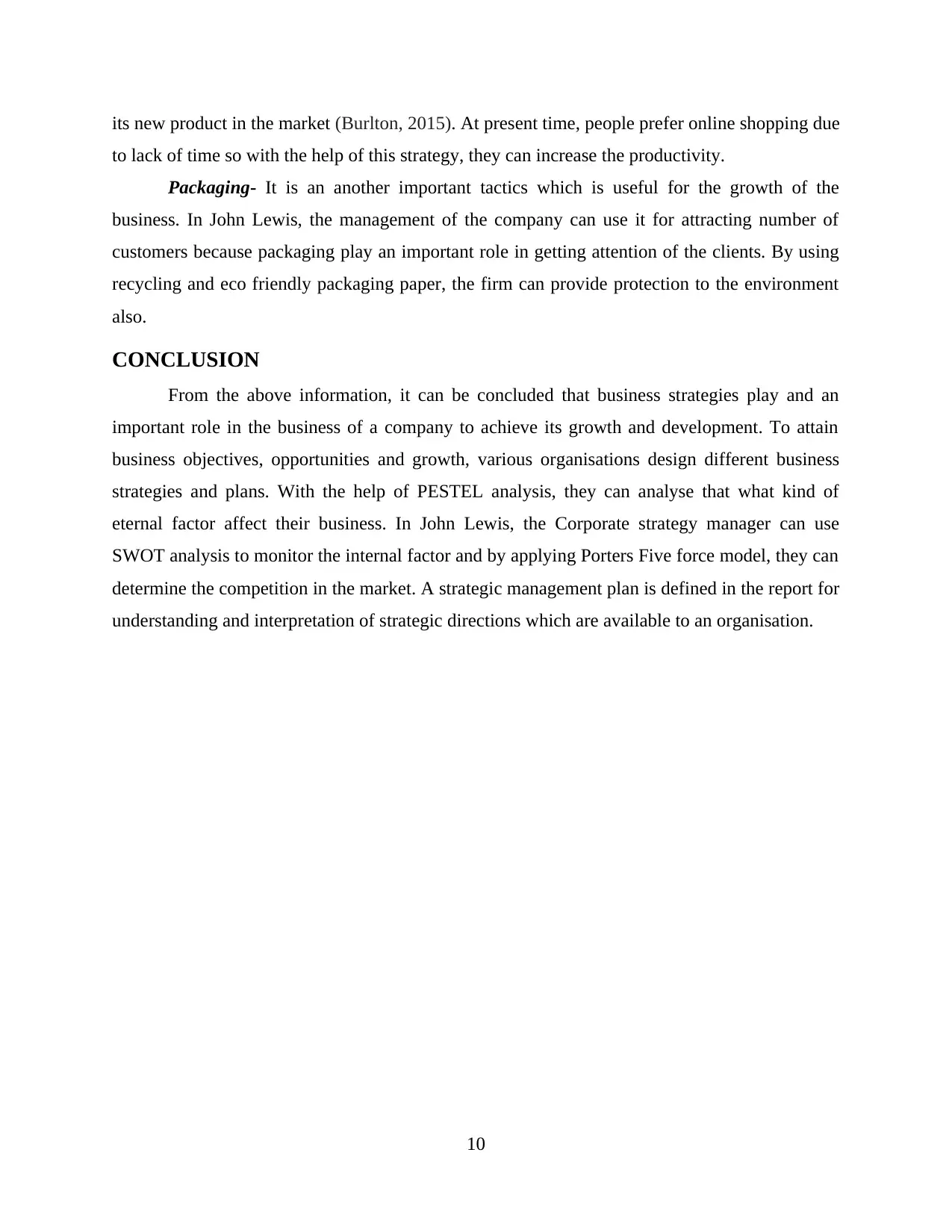
its new product in the market (Burlton, 2015). At present time, people prefer online shopping due
to lack of time so with the help of this strategy, they can increase the productivity.
Packaging- It is an another important tactics which is useful for the growth of the
business. In John Lewis, the management of the company can use it for attracting number of
customers because packaging play an important role in getting attention of the clients. By using
recycling and eco friendly packaging paper, the firm can provide protection to the environment
also.
CONCLUSION
From the above information, it can be concluded that business strategies play and an
important role in the business of a company to achieve its growth and development. To attain
business objectives, opportunities and growth, various organisations design different business
strategies and plans. With the help of PESTEL analysis, they can analyse that what kind of
eternal factor affect their business. In John Lewis, the Corporate strategy manager can use
SWOT analysis to monitor the internal factor and by applying Porters Five force model, they can
determine the competition in the market. A strategic management plan is defined in the report for
understanding and interpretation of strategic directions which are available to an organisation.
10
to lack of time so with the help of this strategy, they can increase the productivity.
Packaging- It is an another important tactics which is useful for the growth of the
business. In John Lewis, the management of the company can use it for attracting number of
customers because packaging play an important role in getting attention of the clients. By using
recycling and eco friendly packaging paper, the firm can provide protection to the environment
also.
CONCLUSION
From the above information, it can be concluded that business strategies play and an
important role in the business of a company to achieve its growth and development. To attain
business objectives, opportunities and growth, various organisations design different business
strategies and plans. With the help of PESTEL analysis, they can analyse that what kind of
eternal factor affect their business. In John Lewis, the Corporate strategy manager can use
SWOT analysis to monitor the internal factor and by applying Porters Five force model, they can
determine the competition in the market. A strategic management plan is defined in the report for
understanding and interpretation of strategic directions which are available to an organisation.
10
⊘ This is a preview!⊘
Do you want full access?
Subscribe today to unlock all pages.

Trusted by 1+ million students worldwide
1 out of 13
Related Documents
Your All-in-One AI-Powered Toolkit for Academic Success.
+13062052269
info@desklib.com
Available 24*7 on WhatsApp / Email
![[object Object]](/_next/static/media/star-bottom.7253800d.svg)
Unlock your academic potential
Copyright © 2020–2025 A2Z Services. All Rights Reserved. Developed and managed by ZUCOL.





